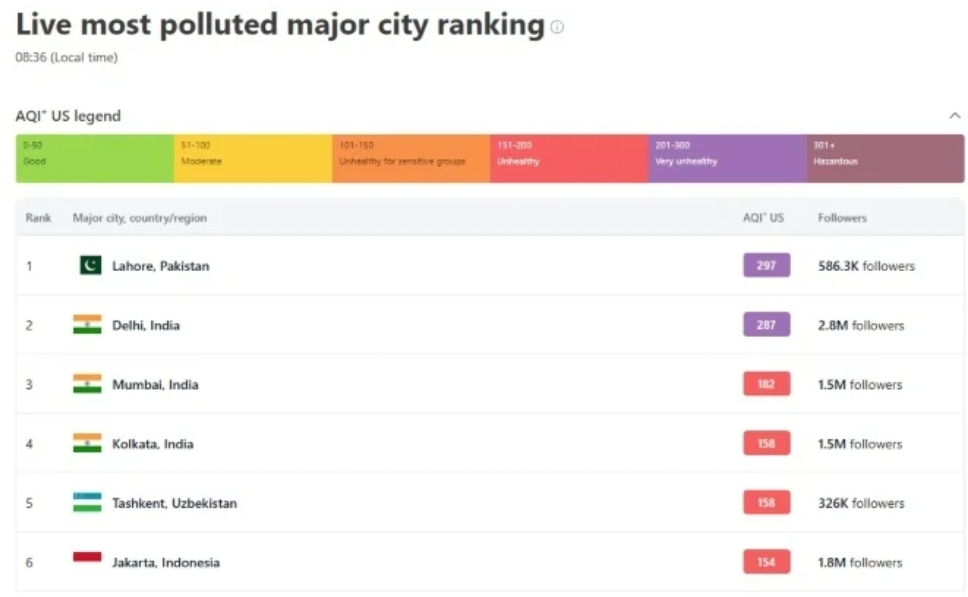Lahore-UNS Lahore ranked as the world’s most polluted major city on Monday morning, as temperatures dip, with air quality deteriorating to “very unhealthy” levels, according to Swiss monitoring group IQAir.
At around 8:00am, the city’s Air Quality Index (AQI⁺) stood at 297, with PM2.5 concentrations reaching 222.5 micrograms per cubic meter of air, around 44.5 times higher than the World Health Organisation’s annual guideline value.
The fine particulate matter, small enough to enter the bloodstream, poses severe health risks to residents, particularly children, the elderly, and those with respiratory illnesses.
Lahore was followed by New Delhi (287), Mumbai (182) on the global pollution chart. Other cities in the top 10 included Kolkata (158), Tashkent (158), Jakarta (154), Dhaka (152) and Dubai (152), with three Indian cities in the top five.
On Sunday, the city’s average AQI was recorded at 160, categorised as “unhealthy”.
According to IQAir data, PM2.5 was the dominant pollutant, measuring 13.7 times the WHO’s annual guideline value. Environmentalists said the persistence of PM2.5 pollution indicated that civic agencies such as the Lahore Development Authority (LDA) and Metropolitan Corporation Lahore (MCL) were failing to implement anti-smog standard operating procedures during ongoing development and construction projects.
They urged Chief Minister Maryam Nawaz to order an immediate halt to large-scale infrastructure and construction activity across Punjab — especially in Lahore and other major cities — warning that without intervention, “the situation will continue to worsen.”
Meanwhile, Punjab Senior Minister Marriyum Aurangzeb said that, on the chief minister’s instructions, nine provincial departments had launched a “grand operation” to combat smog. She said that the combined efforts of government departments and public cooperation had brought Lahore’s AQI “under control.”
Aurangzeb said environmental protection teams were in the field, brick kilns were being monitored by drones, and live reports were being issued daily. She said that smog guns and air quality monitors are deployed, and for the first time, a coordinated All-of-Government strategy has controlled AQI levels according to forecasts.
She added that a modern meteorological data centre was identifying high-pollution zones in advance, enabling targeted action in “smog hotspots.” Departments had been instructed to cover construction materials, while traffic police were directed to restrict heavy vehicles during daylight hours. Agencies, including WASA, LDA, PHA, C&W, and the Agriculture Department, had launched spraying and enforcement operations, including a crackdown on stubble burning across Punjab.
The megacity has remained a fixture on global pollution charts, frequently ranking among the most contaminated urban centres in the world. Air quality in Lahore usually worsens during the winter season from October to February when farmers in the wider Punjab province set light to the remnants of crops, producing smoke that adds to smog. At the same time, weather changes mean pollutants remain trapped in the air for longer.
Air pollution in Lahore is caused by a combination of vehicle and industrial emissions, smoke from brick kilns, the burning of crop residue and general waste, and dust from construction sites. Other factors of air pollution include large-scale losses of trees to build new roads and buildings.
Winter air pollution is worse due to temperature inversion, which results in a layer of warm air that is prevented from rising trapping air pollutants.
Last year, IQAir recorded Lahore’s pollution peaking at a hazardous AQI of 1,110 on November 14, when PM2.5 levels hit 632 micrograms per cubic meter of air, prompting authorities to declare a province-wide health emergency. Schools were shut, universities moved classes online, and a construction ban was imposed to mitigate the crisis.
Last year, however, the smog season began earlier than usual and intensified more severely. Experts warned that the concentration of PM2.5 particles had already surpassed hazardous thresholds — marking some of the highest readings in five years.




